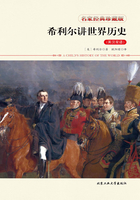
5 真正的历史由此开始
你们都能够记住自己生活中发生的一些重大事件吧。
或许你们曾听到爷爷奶奶或者爸爸妈妈说起过他们一生中发生的一些事情,比如第二次世界大战、朝鲜战争或者越南战争。
而你们的爷爷奶奶,自然也像你们一样,也有他们的爸爸妈妈、爷爷奶奶和曾祖父曾祖母。
或许,你们的
爷爷的
爷爷的
爷爷的
爷爷
可能生活在华盛顿当美国总统的那个时代,而他的
爷爷的
爷爷的
爷爷的
爷爷的
爷爷的
爷爷
则可能生活在裘力斯·恺撒的那个年代呢。
虽然被我们所称的这些“祖先”很久以前就已经去世了,但他们老早、老早以前的一生中所发生的故事,却被人们用书本记载下来了,而这种记载,就是历史;有个男孩,还称之为“他的故事”呢。
Two thousand years may seem a long time. But perhaps you have seen or heard of a man or a woman who was a hundred years old.Have you?
Well,in two thousand years only twenty people,each a hundred years old,might have lived one after the other—twenty people one after the other since the time of Christ—and that doesn't seem so long after all!
Everything that happened before Christ was born is called B. C.,which you can guess are the initials of Before Christ,so B.C.stands for Before Christ.So much is easy.
Everything that has happened in the world since the time of Christ is called A. D.This is not so easy,for though A.might stand for After,we know D.is not the initial of Christ.
As a matter of fact,A. D.are the initials of two Latin words,Anno Domini.Anno means in the year,Domini of the Lord,which in ordinary,everyday language means of course since the time of Christ.
I have told you about things I have had to guess at. We call these things before-history,or pre-history,which means the same thing.But the things that have happened in the lifetime of people who wrote them down—the stories I don't have to guess at—we call history.The first history that we feel fairly sure is true begins with the people in North Africa and the Middle East.
Some people began writing down their stories thousands of years ago.What’s
基督诞生于公元1年;当然,公元1年可不是世界诞生的那一年。
你们知道从公元1年到现在已经过去了多少年吗?
假如你们知道今年是公元多少年,那就能说出公元1年是多少年以前了。
如果基督活到今天,他又会有多大年纪了呢?
两千多年,看上去可是很长的一段时间。不过,你们可能看见过,或者听说过百岁老人吧,有没有呢?
那么,两千年就只是二十个百岁老人一个接一个地活着的这段时间,即从公元1年起,一个接一个地活到一百岁所经历的那一段时间;这样来看,就一点儿也不长了吧!
基督降生之前发生的一切事情,都被称为发生在“公元前(B.C.)”多少年;你们可以猜到,B.C.就是“基督之前(Before Christ)”的英文首字母的缩写,因此“公元前”代表的就是“基督降生之前”。多么简单啊。
而自从基督降生以来,世间所发生的一切事情,就都被称为发生在“公元(A.D.)”多少年了。但这个词猜起来,就没有那么容易了;因为尽管“A.”可能代表“之后(After)”,但我们知道,“D.”并不是“基督(Christ)”这个英文单词的首字母。
事实上,“公元(A.D.)”是“Anno Domini”这两个拉丁语单词的首字母。“Anno”指的是“在那一年”,“Domini”指的是“神的”,因此,用普通的日常
interesting is that different peoples in parts of the world that were really far apart figured out all by themselves how to write,and they did this at different times. Ancient people in the Middle East invented a written language called cuneiform.Ancient people in Egypt wrote in hieroglyphics.Centuries ago,people in India were writing in Sanskrit.People as far away as China,Nubia,and Central America invented their own writing.So did people on the island of Crete in the Mediterranean Sea,halfway between Egypt and Greece.
Today,we know how to read some of these languages from several thousand years ago. But other languages are like an unsolved puzzle.We see the writing,but we don't have any idea what it means.
If you think about all these early civilizations,which ones do you suppose we know the most about?The ones whose writing we can read,or the others?Well,I'll bet you all guessed the right answer to that question!Of course,we know the most about places whose stories we can read.
Four places whose early stories we can read about are Egypt,Mesopotamia,India,and China. We can read their writing,so we know what people were there during all those long years ago.We're not as good on the writing of Nubia or Central America or Crete,so we don't know as much about what was happening in those places long,long ago.
What's really interesting is what we do know about the places whose history we can read. We know that all four of those ancient civilizations grew up along river valleys.
语言来说,“Anno Domini”当然就是指“自基督降生以来”了。
前面我已经跟你们说过了我只能去猜测的一些事情。这些事情,我们称之为“有史以前”或“史前”时期发生的事情;这两种说法,意思是一样的。但是,对于人们记录下来的、他们自己一生当中所发生的事情,也就是我不用去猜测的那些事情,我们则称之为“历史”。大部分人认为属于真实的第一段历史,就是从生活在北非和中东地区的人类开始的。
有些人在几千年前便开始将自己的经历记录下来了。有意思的是,尽管不同民族生活在世界各地,彼此天各一方,但他们都是自行发明出了书写方法,只是发明的时间不同罢了。中东地区的古人发明了一种被称作“楔形文字”的书写语言。埃及的古代人则用“象形文字”来书写。几百年之前,印度人还在用梵文书写呢。远至像中国、努比亚和中美洲地区的人,全都发明了各自的书写文字。而地处埃及和希腊之间的克里特岛上的人,也发明了自己的文字。
这些几千年前写下的语言文字,如今我们已经理解了一些。但还有一些语言文字,却像是一个个没有破解的谜语那样。我们看得见这些文字,却根本不知道它们的意思。
想一想所有这些早期文明的话,你们觉得,我们最了解的应该是哪一种呢?是我们能够读懂其文字的文明呢,还是其他的文明?好吧,我敢打赌,你们都会猜中这个问题的正确答案!我们最了解的,当然是我们能够读懂其历史的那些地方。
有四个地方的早期历史,我们都能够读懂;它们就是:埃及、美索不达米亚、印度和中国。我们能够读懂这些地方的文字,因此知道在如此漫长的过去居住在这
Egypt was built along the Nile River valley. And Mesopotamia grew along the valleys of two rivers—the Tigris and the Euphrates.But you already know about those rivers.
Now here are two new rivers for you. India's first history took place along the valley of the Indus River and China's along the Huang River.The Huang River is sometimes called the Yellow River because the river's bottom is thick yellow mud.
Even though they lived far apart,the peoples who lived along these rivers did a lot of the same things. This isn't too surprising when you think about it.You may never have visited Africa or India or China today,but you can guess that girls and boys there play games,and that mothers cook,and so on.Even in ancient times,people around the world did many of the same things.
The river valleys were a good place to live because food was plentiful. There was lots of water for animals to drink,and to use to water plants.So men and women and boys and girls all settled down next to the rivers—in Egypt,in Mesopotamia,in India and in China.
Soon enough people were living so close together that they were living in what we call a town. Then people in these towns began to build little boats,then bigger boats.Soon the boats were sailing up and down the river to the next town and to towns farther away.The towns began to trade with each other.And sometimes the towns began to fight with each other.
One of the best ways to stop the towns from having little wars was to put them all under
些地方的都是些什么样的民族。而对于努比亚、中美洲或克里特岛等地的文字,我们则不那么了解,因而对很久、很久以前这些地方发生的情况,也就了解不多。
真正有意思的,便是对能够读懂其历史的这些地方,我们已经切实了解到的那些情况。我们知道,这四大古代文明,都是沿着河流流域发展起来的。
埃及是沿着尼罗河流域发展起来的。美索不达米亚是沿着两河流域,即底格里斯河流域和幼发拉底河流域发展起来的。而对这几条河流,你们都已经有所了解了。
在这里,你们又会接触到两条新的河流。古印度的历史,发源于印度河流域,而中国的历史则发源于黄河流域。“黄河”有时又被叫作“黄色之河”,因为这条河流的河底,全是厚厚的黄色泥沙。
尽管相距遥远,但生活在这些河流两岸的不同民族,所作所为却有很多相同的地方。仔细想一想,你们就会明白,这没什么可惊讶的。如今,虽说你们可能从来没有到非洲、印度或者中国去旅游过,但你们完全猜想得出,那里的小朋友们也在做游戏,那里的妈妈们也在做饭,等等。就算是在古代,世界各地人们的所作所为,也有很多是相同的呢。
河流两岸是适合人类生活的地方,因为那里的食物会很充足。那里有充沛的河水可供动物饮用和浇灌植物。于是,埃及、美索不达米亚、印度和中国等地的男女老少,便全都是临河而居。
不久之后,一些地方生活的人越来越多、越来越密集,便形成了我们所称的市镇。接下来,生活在这些市镇里的人开始建造一些小型的船只,然后又开始建造较大的船只。很快,船只便开始在河流里面上下航行,往来于附近市镇和更远的市镇
the rule of one
person. So,in place after place,a government grew up.Sometimes the towns agreed to get together.Other times they were united when one strong man conquered his neighbors.Either way,a king,or emperor,or pharaoh was in charge of the government and was ruler of what we now call a nation.
So,if you look back at these river civilizations,you can see a piece of history that is really quite remarkable. At a time when many people were still hunters and gatherers,maybe even living in caves,something new and exciting was happening first in Egypt and Mesopotamia and soon afterwards in India and China.People settled down and farmed,then built towns,then traded with each other,and then built nations.And,sometime during all this,they figured out that it would be a great thing to write—and so they wrote down their history for us to read today.

Trading boat of river valley town
河流两岸市镇间进行贸易的船只
之间了。于是,市镇之间便开始进行相互贸易。有的时候,市镇之间也会彼此征战。
阻止市镇之间爆发小规模战争的最佳办法之一,就是将这些市镇全都掌控在一个人的统治之下。于是,各地便一个接一个地出现了政府。有的时候,是各个市镇一致同意团结起来。其他时候,则是由一个强有力的人物征服邻近市镇而将它们统一起来。但不论是哪种方式,都是由一个国王、皇帝或者法老来掌控政府,这个掌控政府的人便成为我们如今所称的一国之君。
所以,假如回顾一下这些流域文明的历史,你们便会明白,这一段历史的确是非比寻常的。在许多民族仍然只会狩猎和采集果实、甚至仍然居住在洞穴之中的时候,某种新的、令人激动的东西率先在古埃及和美索不达米亚地区出现了,不久后在古印度和中国也开始出现。人们定居下来,开始耕作,然后又建立市镇,彼此贸易,然后又建立了国家。并且,在这一过程中的某个时候,他们又认识到,书写是一件很了不起的事情,于是他们便将自己的历史记录下来,供我们如今来阅读。